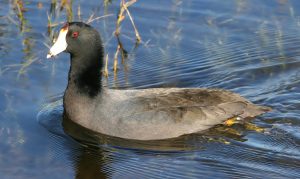Hey there, fellow nature explorer! Let’s talk about a couple of feathered friends you might run into around wet and watery spots in Pinellas County: the American Coot and the Common Gallinule. You can catch them chilling by lakes, ponds, and marshes, rocking their snazzy red or orange beaks. Now, these two birds might seem like they went shopping together for their dark-colored outfits and colored face masks, but they’re not identical twins! While they both belongs to the family Rallidae, more commonly known as rails, there are some cool tricks to tell them apart. By getting the scoop on their stylish looks, what they’re into, and their favorite hangouts, you’ll be a pro at spotting these awesome water-loving pals!
Bills
The most obvious difference between the American Coot and the Common Gallinule is the color of their bill and frontal shield. The American Coot, also known as the mud hen or marsh hen, is a medium-sized waterbird with a short, thick, white bill and white frontal shield, which usually has a reddish-brown spot near the top of the bill between the eyes. The Common Gallinule (formerly known as the Common Moorhen and sometimes referred to as a “swamp chicken”) is a medium-sized waterbird that has a red shield on the forehead during the breeding season, and its bill is red at the base and yellow at the tip. I have tried for years to come up with a way to remember this and finally came up with this…if it works for you, great! If not, I’m sorry…What is a very “common” fast food restaurant known for its red and yellow branding? McDonalds! McDonalds (yellow and red) are common like the yellow and red bill of the “common gallinule”.


Tail
If you’re able to get a look at the rump of these birds, you may note the presence or absence of any white coloration. The American Coot has small and not very visible white marks on its tail feathers, whereas the Common Gallinule has a longer, more distinct tail with obviously white markings along the sides of its tail and wing feathers.
Feet
If you’re able to catch a glimpse of their feet, wow do they look different. Let’s just say I did a quick search for “American Coot feet” and at the top of my search was an article titled, “Better Know a Bird: The American Coot and Its Wonderfully Weird Feet”. If you were to catch a quick glimpse of a picture of the feet of an American Coot, you might think you’re looking at a picture of feathers. Their feet as described in this article states, “The bird’s long, yellow-green toes have two to three fleshy lobes…” So get this, these magical feet are designed for this bird’s life on land and in water. These so-called “lobes” enable the coot to push through the water and even help them “run” on water as they frantically flat their wings to take flight from a water body. When on land, they fold up to help with walking on a variety of surfaces. The common gallinule has very long toes that appear almost too big for their body, but these long toes aid them to walk on top of aquatic vegetation and mucky substrates.
Both species are found statewide; however, the American Coot tends to be more of a winter visitor.
We also created a short video on how to tell these two species apart if you’re more of a visual learner. Check it out on our YouTube Channel: This or That? Common Gallinule or American Coot
 3
3
